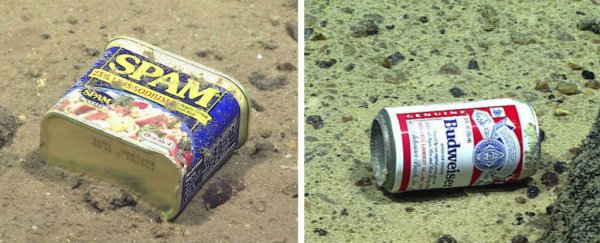Turns out, even the most remote parts of Earth aren't safe from our trash and toxic pollution.
Scientists have found that "extraordinarily high" levels of banned industrial chemicals are contaminating marine life more than 10 km deep (6 miles) into the Mariana Trench, and just a few kilometres above that, beer cans and plastic bags litter the seabed.
A team from Newcastle University in the UK has been sampling small, prawn-like crustaceans called amphipods from the depths of two of the world's deepest trenches - the Mariana Trench in the Pacific Ocean, and the Kermadec Trench near New Zealand.
Despite the fact that these trenches are both more than 10 km deep and located some 7,000 km (4,340 miles) apart, the researchers found extremely high levels of toxic chemicals in amphipods collected from each.
And when we say "extremely high", that's even compared to some of the most polluted places in the world.
The highest levels of polychlorinated biphenyls (PCBs) - chemicals banned in the 1970s after being linked to cancer - found in amphipods from the Mariana Trench were 50 times greater than levels found in crabs near the Liaohe River system, one of the most polluted rivers in China.
The level is only rivalled by one other place on Earth - Suruga Bay in Japan, an "infamous pollution blackspot".
"We still think of the deep ocean as being this remote and pristine realm, safe from human impact, but our research shows that, sadly, this could not be further from the truth," says one of the team, Alan Jamieson.
"In fact, the amphipods we sampled contained levels of contamination similar to that found in Suruga Bay - one of the most polluted industrial zones of the northwest Pacific. What we don't yet know is what this means for the wider ecosystem, and understanding that will be the next major challenge."
This isn't the first we've heard of pollution accumulating in the depths of the world's oceans.
Just last year, the NOAA Office of Ocean Exploration and Research reported finding actual garbage in parts of the Mariana Trench, including a beer can, a Spam food tin, a piece of rope, and a plastic bag.
And as confronting as that is to see, we shouldn't be all that surprised - thanks to the remoteness of the deep sea, it's been used as a dumping ground for everything from pharmaceutical waste to unwanted World War munitions and chemical weapons.
"We're very good at taking an 'out of sight out of mind' approach when it comes to the deep ocean, but we can't afford to be complacent," says Jamieson.
"The fact that we found such extraordinary levels of these pollutants in one of the most remote and inaccessible habitats on earth really brings home the long term, devastating impact that humankind is having on the planet.
The researchers used deep-sea landers to comb the Mariana and Kermadec trenches for amphipods, and tested their fatty tissues for signs of pollutants called Persistent Organic Pollutants (POPs).
POPs are a group of highly contentious chemicals that have seen widespread use in the recent past, including pesticides such as DDT, and industrial chemicals such as the now-banned PCBs, and PBDEs (polybrominated diphenyl ethers).
Unlike PCBs, PBDEs are still in production, despite noted health concerns. Neither chemical breaks down in the environment, which means once it's contaminated an area, it's extremely difficult to remove it.
To give you an idea of the scale of use these chemicals have enjoyed, the team reports that between the 1930s to the 1970s, the total global production of PCBs totalled roughly 1.3 million tonnes.
The researchers found PCBs and PBDEs in amphipods from both trenches, and suggest that they initially accumulated in the fatty tissue of larger animals, such as orcas and dolphins - something previous research has confirmed.
When these animals die, their contaminated carcasses fall to the depths of the ocean to be feasted on by smaller creatures, which carry on the contamination.
"The very bottom of the deep trenches like the Mariana are inhabited by incredibly efficient scavenging animals, like the 2-cm-long amphipods we sampled, so any little bit of organic material that falls down, these guys turn up in huge numbers and devour it," Jamieson told Damian Carrington at The Guardian.
"When [POP] gets down into the trenches, there is nowhere else for it to go. The surprise was just how high the levels were - the contamination in the animals was sky high."
Now that we know the level of pollution being carried around by creatures in the Mariana and Kerdamec trenches, researchers are tasked with figuring out what this means for marine life living even deeper than the sampled amphipods.
Jamieson says the next step of their research will be to investigate the levels of plastics in deep sea animals - and we shouldn't be surprised if he turns up a whole lot of microbeads.
"It's not a great legacy that we're leaving behind," he says.
The research has been published inNature Ecology and Evolution.
